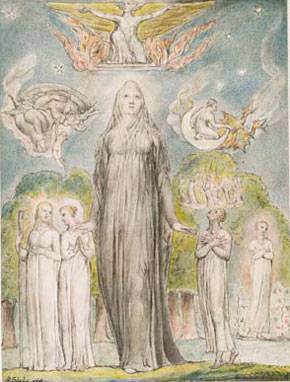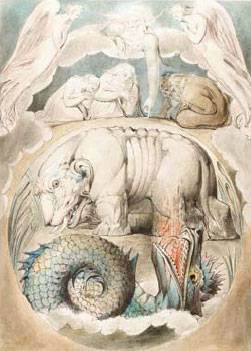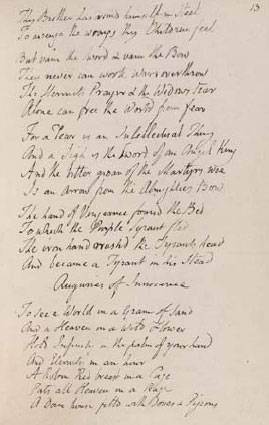
William Blake, “Melancholy,” from John Milton’s Il Penseroso, watercolor, over traces of black chalk.
Purchased with the assistance of the Fellows with the special support of Mrs. Landon K. Thorne and Mr. Paul
Mellon, 1949; 1949.4:7.

William Blake, “Behemoth and Leviathan,” from Illustrations for the Book of Job, ca. 1805–10, no 15 in the set of 21 illustrations, pen and black ink, gray wash, and watercolor, over traces of graphite. Purchased by Pierpont Morgan, 1903; 2001.77.

William Blake, The Pickering Manuscript, ca. 1802–04, autograph manuscript fair copy of tenpoems, page 13. Gift of Mrs. Landon K. Thorne,1971; MA 2879.
William Blake’s World: ‘A New Heaven Is Begun’ – Morgan Library and Museum
Visionary and nonconformist William Blake (1757–1827) is a singularfigure in the history of Western art and literature: a poet, painter, and printmaker. Ambitiously creative,Blake had an abiding interest in theology and philosophy, which, during the age of revolution, inspiredthoroughly original and personal investigations into the state of man and his soul. In his lifetime Blake wasbest known as an engraver; he was later recognized for his innovations across many other disciplines.
from September 11, 2009,to January 3, 2010
]]>
In the Morgan’s first exhibition devoted to Blake in two decades,former director Charles Ryskamp and curators Anna Lou Ashby andCara Denison have assembled many of Blake’s most spectacularwatercolors, prints, and illuminated books of poetry to dramaticallyunderscore his genius and enduring influence. William Blake’s World: “ANew Heaven Is Begun”—the subtitle a quote from Blake referring to thesignificance of his date of birth—is on view from September 11, 2009,to January 3, 2010.
The show includes more than 100 works and among the manyhighlights are two major series of watercolors, rarely displayed in theirentirety. The twenty-one watercolors for Blake’s seminal illustrationsfor the Book of Job—considered one of his greatest works andrevealing his personal engagement with biblical texts—were created about 1805–10. Also on view are twelve drawings illustrating JohnMilton’s poems L’Allegro and Il Penseroso, executed about 1816–20. Both series were undertaken for Blake’sprincipal patron, Thomas Butts.
“The name William Blake means different things to different people,” said William M. Griswold, director ofthe Morgan. “Engraver, painter, poet, visionary—all apply to Blake, and all are accurate. The Morgan isfortunate to have one of the most important collections of Blake material in the world, and this exhibitionprovides an opportunity to see his extraordinary creativity across many disciplines.”
In addition to the superlative watercolor series—twenty-one illustrations to the Book of Job and twelvedesigns illustrating Milton’s L’Allegro and Il Penseroso—other important drawings are on display, includingFire (ca. 1805), which addresses the subject of war. The more fully expressed Continental Prophecies, a series ofthree illuminated books, further showcase Blake’s talents as a visual artist and his passionate interest inpolitics.
Among Blake’s crowning achievements as a visual artist and poet are his illuminated books, such as Songs ofInnocence and of Experience: Shewing the Two Contrary States of the Human Soul (ca. 1794). These works, whichalso showcase his exceptional technical skills, reflect medieval manuscript illumination and theinterrelationship between word and image. Also on view is the only dated copy of Blake’s dramatic TheMarriage of Heaven and Hell.
Shedding light on the artistic milieu surrounding Blake are a number of works by friends andcontemporaries, including drawings by younger artists such as John Linnell (1792–1882) and members of agroup that assembled around Blake and called themselves the Ancients. Also represented are works bypainters such as Samuel Palmer (1805–1881) and Henry Fuseli (1741–1825).
Follow us on:


